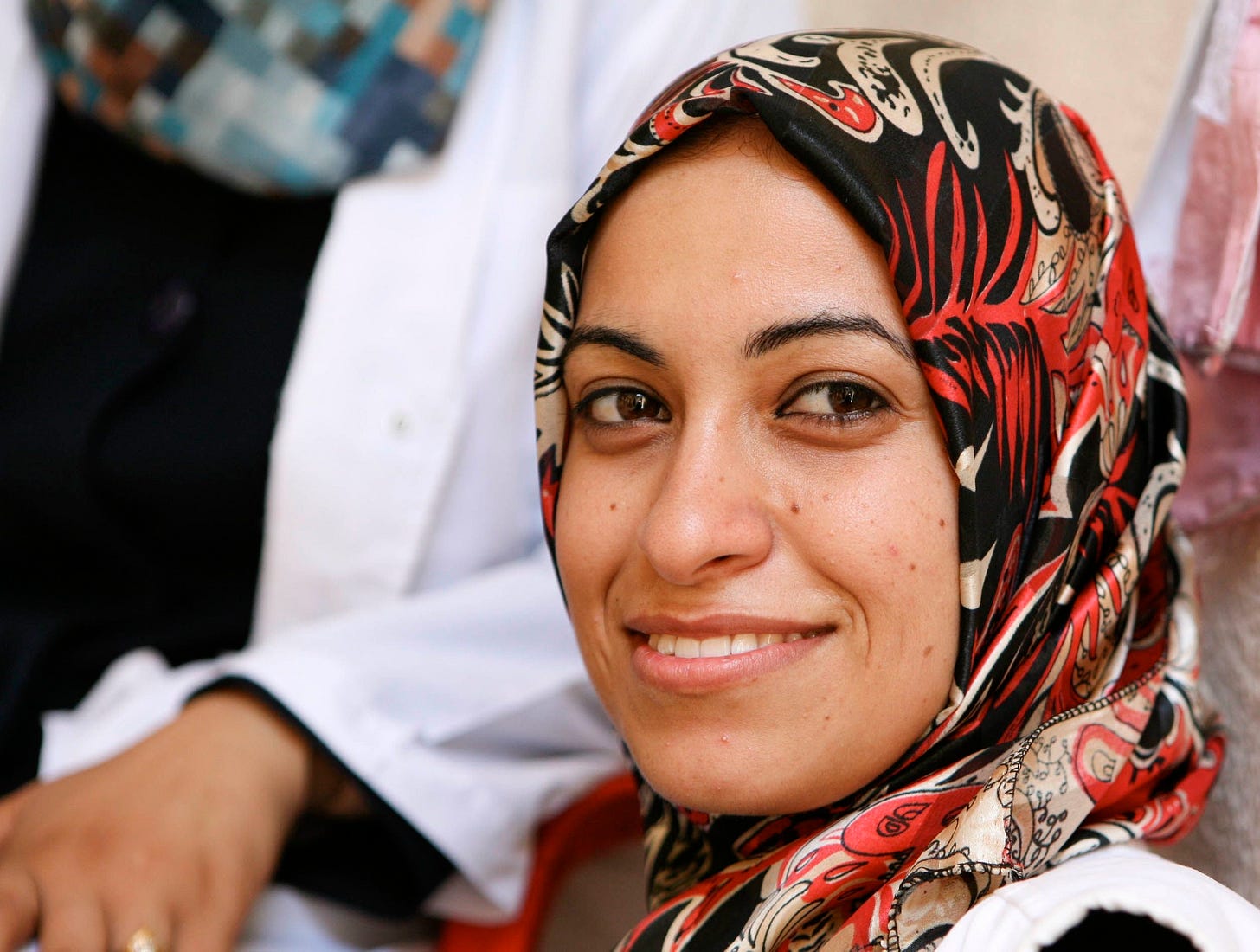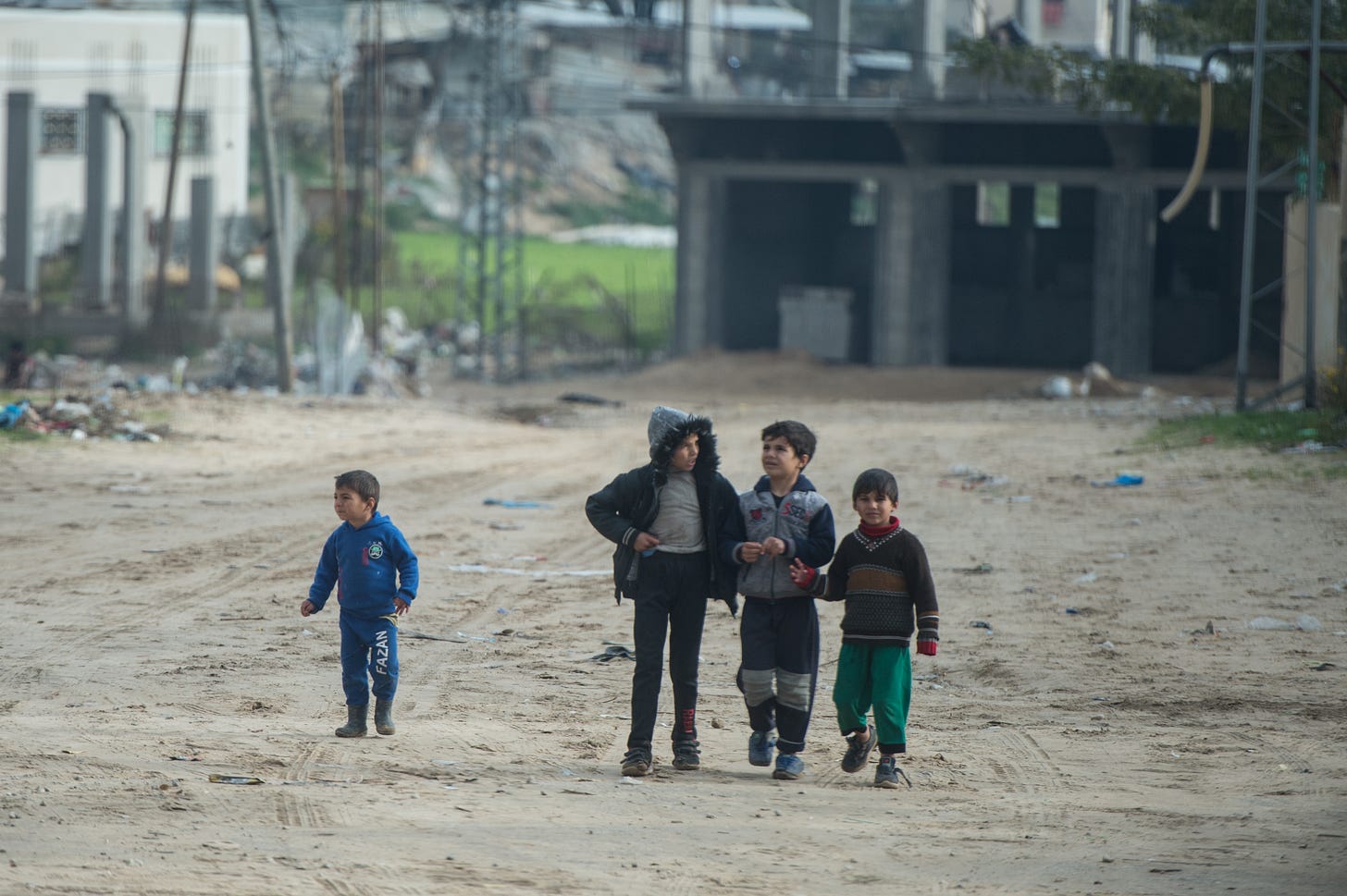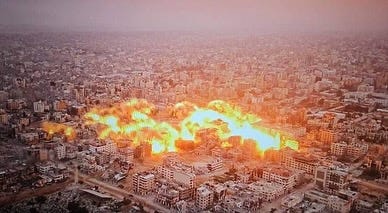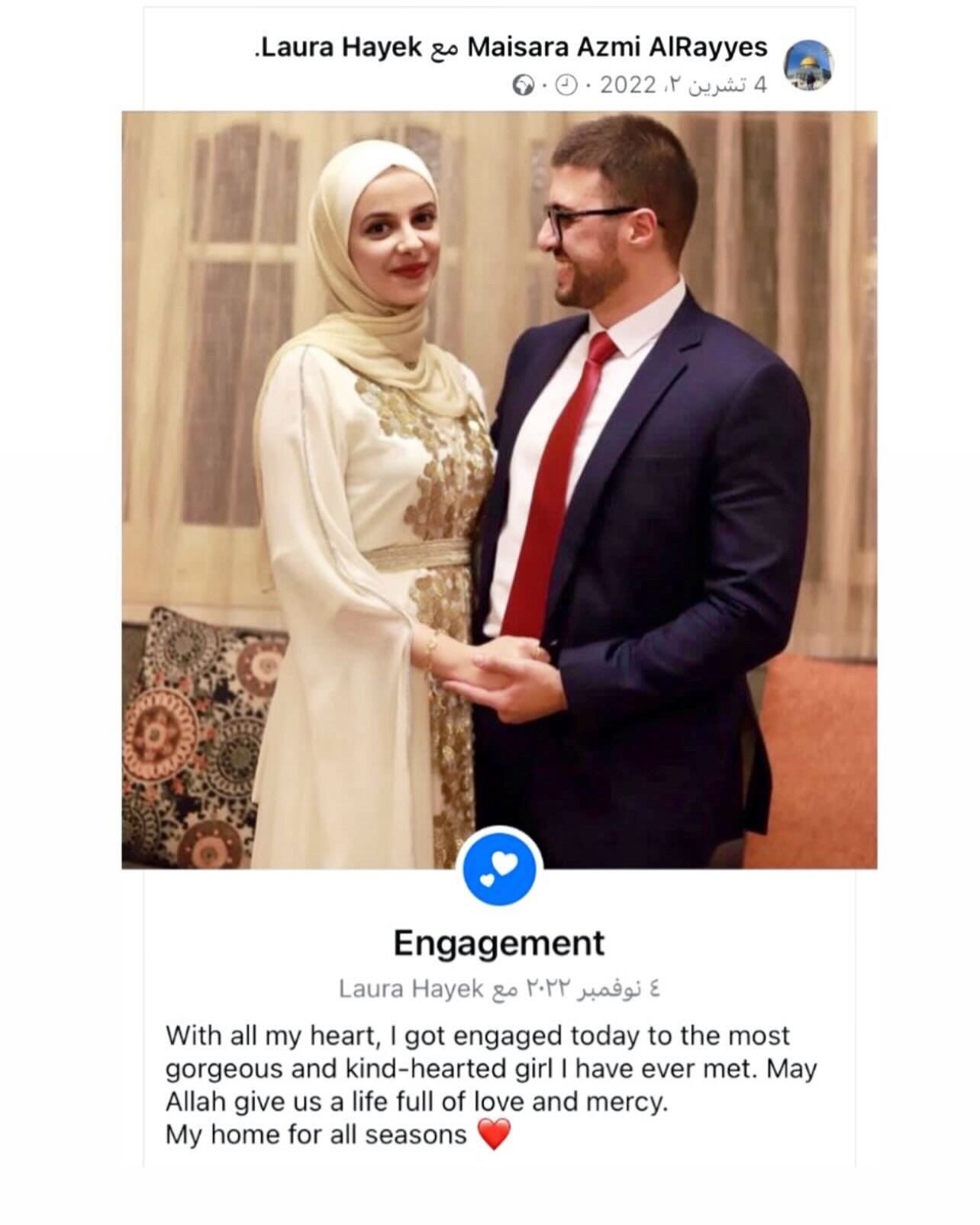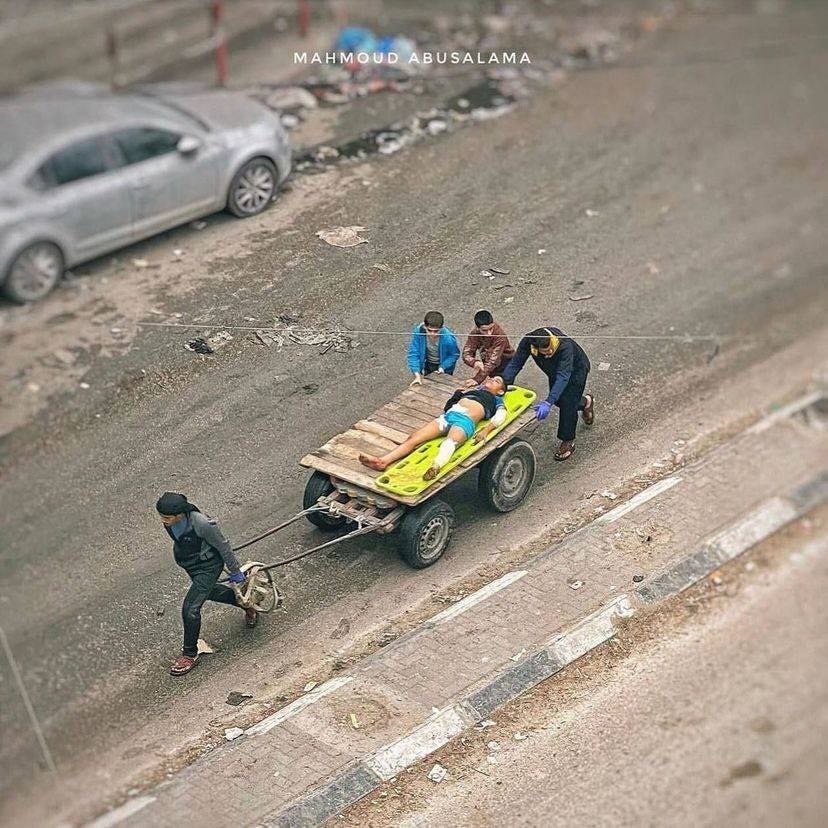Gaza: An Untold Story
The humanity of Gazans not portrayed by the American media. (2006-2023)
Video (6 min 56 sec), Created: Jan 6, 2024
The humanity of Gazans not portrayed by the American media.
The YouTube version must be Watched on YouTube because it contains depictions of violence is age restricted.
Why create a new video?
This video was requested. It attempts to humanize Gazans and educate Americans in the context of an English language media that overwhelmingly portrays the Israeli perspective.
Footage from 10/7 is readily available in US media, but ..
Most Americas (and Israelis) do not see images that humanize Gazans, enabling those who go far beyond Israel’s stated goal of defeating Hamas militants
This video attempts to portray the humanity of Gazan civilians to Americans who are unaware of:
The 5 recent "wars" in Gaza: 2008, 2012, 2014, 2021, 2023
"The Great March of Return" protests 2018-19
The Israeli "Dahiya" military doctrine, which originated in the 2006 war with Lebanon.
More information, with Twitter links:
New Israeli +972 Magazine Report Exposes Spokesperson Mark Regev's Lies.
4 Categories of Bombing Targets: “Power Targets”
Note:
Although I’ve worked as a computer programmer for the last 20+ years, I was a History major at university and have rediscovered my love of research, writing, and creativity through recent projects.
If you or someone you know is aware of paid work doing research and writing please get in touch.
This document:
Here are links to the underlying source material and the photographers who took them.
I made an effort to contact those photographers who haven’t made their work available under creative commons licenses but internet access did not seem to be readily available in Gaza at the time.
I made the decision to err on the side of sharing these (less than full quality social media post) images for what I feel is a compelling public interest.
I credit the original photographer and link to them whenever possible.
2006 Lebanon War: Israel was not able to defeat Lebanon
IDF Spokesperson's Unit / CC BY-SA 3.0
Israel adopts the Dahiya Doctrine
— using disproportionate force against civilian “infrastructure” to create unbearable civilian suffering with the hope that this will pressure militants
Stefanos Kouratzis
Sent Contact form
Made in the Image of God
Michelangelo (cropped)
Gazan children
March 3, 2007 stichting kifaia. Photo: Anja Meulenbelt
Boy with the knit top turns his head
Dec 1, 2007 stichting kifaia. Anja Meulenbelt
Gazan Beach Boys
Aug 14, 2008 stichting kifaia. Anja Meulenbelt
Gazan Woman Colorful Red headscarf
August 17, 2008 stichting kifaia. Photo: Anja Meulenbelt
Gazan Woman with Red and White Headscarf
Feb 19, 2009. stichting kifaia. Photo: Anja Meulenbelt
https://flickr.com/photos/kifaia/5514169275/in/photostream/
Gazan child in rubble
10 March 2009. Rami Tarawneh
Creative Commons Attribution-Share Alike 2.0 Generic
Israel’s “Dahiya Doctrine” comes to Gaza
Daycare Center, Gaza
April 15, 2009 Photo: Marius Arnesen
Sunset at Beach Hotel, Gaza
April 22, 2009, Marius Arnesen
Ruins, Gaza (2009)
April 12, 2009, Marius Arnesen
Protesters of Israelli attack on Gazan aid flotilla
Gaza City Mosque
Jan 12, 2020. Catholic Church England and Wales photostream.
Is this Al-Khalidi Mosque? (flickr | facebook | wikidata)
(Twitter: Al Hassaina Mosque has been leveled)
Gazan mother with toddler
Jan 13, 2020. Catholic Church England and Wales photostream
Gazan children walking in road
Jan 13, 2020. Catholic Church England and Wales photostream
Horror and Grief: Inside Gaza’s Hospitals
For Palestinians in Gaza, medical care is on the brink of collapse.
There have been five Israel-Gaza wars since 2008. These charts show the latest one is by far the deadliest
A Palestinian searches through rubble of his destroyed home hit by Israeli strikes in Towers Al-andaa - the northern Gaza Strip. July 08, 2014
07/08/2014, Shareef Sarhan
UN Photo/Shareef Sarhan
High-ranking officer: Halutz ordered retaliation policy
The officer said that the equation was created by Halutz and that every rocket strike on Haifa would be answered by IAF missile strikes on 10 12-story buildings in the Beirut neighborhood of Dahiya, a Hizbullah stronghold. Since the beginning of Operation Change of Direction, launched on July 12 following the abduction of two soldiers during a Hizbullah cross-border attack, over 80 buildings in the neighborhood have been destroyed.
Jerusalem Post. July 24, 2006 Yaakov Katz
Aljezera: Photos: Israel’s war on Gaza’s children
An aspiring journalist documented Gaza’s beauty, then its destruction
Washingtonpost article about Plestia Alaqad
https://www.instagram.com/byplestia/
People are evacuating in bicycles. They don’t have cars. They don’t have anything
Yesterday, the Israeli warplane hit a church with around 400 civilians inside of it.
Not only are they. being bombarded, they’re starving from the blockade..
“We only eat a quarter of a half of bread in the day” .. the displaced child Ahmad said about the food crisis in Gaza. By @mohammed_fayq
High-ranking officer: Halutz ordered retaliation policy
A high-ranking IAF officer caused a storm on Monday in an off-record briefing during which he told reporters that IDF Chief of Staff Lt.-Gen. Dan Halutz had ordered the military to destroy 10 buildings in Beirut in retaliation to every Katyusha rocket strike on Haifa. The officer said that the equation was created by Halutz and that every rocket strike on Haifa would be answered by IAF missile strikes on 10 12-story buildings in the Beirut neighborhood of Dahiya, a Hizbullah stronghold.
There have been five Israel-Gaza wars since 2008. These charts show the latest one is by far the deadliest
https://www.abc.net.au/news/2023-11-20/six-charts-that-show-the-scale-of-human-loss-in-israel-gaza-war/103074196
Motasem Mortaja
record media 1
Gaza City
The grand Al Hassaina Mosque (مسجد الحساينة) overlooking Gaza’s Mediterranean coast
Motasem Mortaja,, a Palestinian journalist who has been documenting Israel’s war on Palestine’s Gaza, reunited with his daughter for the first time since October 7 (48 days)
Meet Gaza’s street journalists
Wissam Nassar
wissamgaza
International award-winning Photographer. 2015 Pulitzer Prize Finalist.
My pics have appeared in the New York Times, Washington Post, Time and more.
2023:
Israel calls people to let them know they will be bombed.
The poet and academic Refaat Alareer was called while he was in a shelter and given the choice of taking everyone in the shelter with him or leaving the shelter.
A residential block is completely destroyed after the 2014 Truce
A residential block is completely destroyed by Israeli occupation forces in Al Remal
Dec 21, 2023. wissamgaza
Nov-Dec 2023 wissamgaza
Nov 21, 2023. wissamgaza
Nov 2023 wissamgaza
A grandmother prepares food for children on firewood due to a lack of cooking gas.
Nov 2023 wissamgaza
Nov-2023 wissamgaza
Nov - 2023
Nov-2023 wissaamgaza
The massive destruction caused by Israeli warplanes in the Shejaeya neighborhood, east of Gaza.
Nov-8-23 wissamgaza
https://www.threads.net/@wissamgaza/post/C1Y3lACuNZM
https://www.instagram.com/wissamgaza/?hl=en
Nov 5 2023
Dec 2023 @almajd_free
The journalist Ahmad Khair-Eldeen was killed today by Israel in Gaza making the total number of journalists killed 104 since the beginning of the aggression .
Arial view of gaza neighborhood.
#Palestine || A mother embraces her child who was killed by an Israeli air strike in Rafah city, southern Gaza. 21.10.23
Great March of Return:
The March of Return and Israel’s response to it should engender far more attention and publicity in the U.S. than it has thus far ...

https://www.amnesty.org/en/latest/news/2018/04/israelopt-israeli-forces-must-end-the-use-of-excessive-force-in-response-to-great-march-of-return-protests/
Palestinians to resume weekly protests on Gaza border in March
Amnesty International
Israel/OPT: Israeli forces must end the use of excessive force in response to “Great March of Return” protests
April 13, 2018
London, Ont., physician Tarek Loubani shot in leg near Gaza border
Canadian doctor, who was 1 of 19 medical professionals shot Monday, believes he was targeted

The Gaza Strip mourns its dead after protest is met with bullets
Americans Should Know More About The 'March Of Return'
May 29, 2019

Sinai Dessert
Wikipedia
Vyacheslav Argenberg
Two Years On: People Injured and Traumatized During the “Great March of Return” are Still Struggling
Music: (Spotify)
Samuel Barber Adagio for Strings
born in West Chester, Pennsylvania
He was born into a comfortable, educated, social, and distinguished American family. His father was a physician; his mother was a pianist of English-Scottish-Irish descent
Dear Mother: I have written this to tell you my worrying secret. Now don't cry when you read it because it is neither yours nor my fault. I suppose I will have to tell it now without any nonsense. To begin with I was not meant to be an athlet [sic]. I was meant to be a composer, and will be I'm sure. I'll ask you one more thing.—Don't ask me to try to forget this unpleasant thing and go play football.—Please—Sometimes I've been worrying about this so much that it makes me mad (not very).[6]
At the age of 10, Barber wrote his first operetta, The Rose Tree, to a libretto by the family's cook.[4] At the age of 12, he became an organist at a local church. At the age of 14, he entered the youth artist program at the Curtis Institute of Music in Philadelphia
.. The use of tonal harmony, unresolved dissonance, moderate chromaticism, and largely diatonic, lyrical melodies are some of the defining features of this period in his compositional career
In his early career Barber had a brief career as a professional baritone, performing on the NBC Music Guild concert series and earning a weekly contract on NBC radio in 1935.
NPR Music said that "with a tense melodic line and taut harmonies, the composition is considered by many to be the most popular of all 20th-century orchestral works."[5] Thomas Larson remarked that the piece "evokes a deep sadness in those who hear it".
According to music theorist Matthew BaileyShea, the Adagio "features a deliberately archaic sound, with Renaissance-like polyphony and simple tertian harmonies" underlying a "chant-like melody". The work is in "the key of B♭ minor (with some modal inflections)".[10]
The Adagio is an example of arch form and builds on a melody that first ascends and then descends in stepwise fashion
That is because we have here honest music, by an honest musician, not striving for pretentious effect, not behaving as a writer would who, having a clear, short, popular word handy for his purpose, got the dictionary and fished out a long one
Alexander J. Morin, author of Classical Music: The Listener's Companion (2001), said that the piece was "full of pathos and cathartic passion" and that it "rarely leaves a dry eye"
Roy Brewer, writer for AllMusic, said that it was one of the most recognizable pieces of American concert music
As part of a musical retrospective in 2000, NPR named Adagio for Strings one of the 100 most important American musical works of the 20th century, calling it "standard repertoire for today's orchestras, and Barber's best-known work".[16][17]
In 2004, listeners of the BBC Radio's Today program voted Adagio for Strings the "saddest classical" work ever, ahead of "Dido's Lament" from Dido and Aeneas by Henry Purcell, the Adagietto from Gustav Mahler's 5th symphony, Metamorphosen by Richard Strauss, and Gloomy Sunday as sung by Billie Holiday.[18][19]
Chorus with strings (2021) – Jonathan Manners, also setting the Agnus Dei text. Performed on the 20th anniversary of September 11 attacks (9/11) at The Last Night of the Proms 2021, London UK, in memory of those lost. The new arrangement was performed 20 years after the original Adagio for Strings was performed at the 2001 Last Night to honour the memory of the victims of 9/11, conducted by Leonard Slatkin.[20]
Since the 1938 recording, the Adagio for Strings has frequently been heard throughout the world, particularly in times of mourning. It was one of the few American pieces to be played in the Soviet Union during the Cold War.[14]
Barber voiced misgivings with the piece's ubiquity, saying in a 1978 interview, "They always play that piece. I wish they'd play some of my other pieces."[22]
Versions of Barber’s Adagio for Strings
5:56 “Attribution-NonCommercial 4.0 International (CC BY-NC 4.0)”
8:22 David Parry, London Philharmonic
8:57 Sir Simon Rattle, Berlin Philharmonic
9:56 Leonard Bernstein, New York Philharmonic
Common Misinformation:
Atrocity propaganda: NYTimes pushed a narrative of widespread rape with weak or incredible evidence.
Max Blumenthal says Jeffery Gettleman alleges rapes but claims evidence was not permitted because of jewish burial rituals
Many Israeli 10/7 hostages were actually killed by Israeli tanks and helicopter fire which took little effort to differentiate between Hamas fighters and Israeli hostages. See: Hannibal directive. 1 | 2 | 3 | 4 | 5 | 6 | 7
Israel has been trying hard to avoid killing Gazans but “collateral damage” was widespread because of Hamas’s use of Human shields, rather than Israel’s Dahiya doctrine actually seeking ‘unbearable” civilian suffering as a goal.
Hospital Hamas Command Center / Node
Worse than Russian Bloodthirst because Israelis have victimization that prevents humanizing other victims
Hamas is Nazi (cheap tactic for cruel Fundamentalists)
Jews around the world can’t be safe without a state like Israel
Notes:
ITS: Impunity Tautology Shield. (coined here)
A rhetorical technique that shields an individual or group by defining all forms of criticism as illegitimate attacks which victimize the group being criticized.
Examples:
ITS: Israeli Tautology Shield: critics are either self hating jews, or anti-Semitic
Tautology means true by definition. It means that critics are either:
Anti-semitic (classic) = anti-Jewish
Anti-semitic (ITS) = Anti-Zionism is Anti-semitism
Saudi Arabia version
Criticism of Saudi leader Mohammed bin Salman for the killing of journalist Jamal Kashogi could be claimed as “Islamophobic” because you haven’t criticized the killing of all journalists killed by African leaders.
You either support MBS or you are “Islamophobic,” even if you support Muslims who are not Saudi leaders.
You keep using that word. I don’t think it means what you say it means. You’ve diluted what it means
When people can’t beat you with facts, they instead try to smear and pressure you.
Christians in Gaza are being ~decimated too
Read:
Bible
According to the Bible, God created humans in his image, and the image of God is linked to the rationale for prohibiting and punishing murder.
Genesis 1:27, which reads: "So God created man in his own image, in the image of God created he him; male and female he created them.
And God said: 'Let us make man in our image/b'tsalmeinu, after our likeness/kid'muteinu; and let them have dominion over the fish of the sea, and over the fowl of the air, and over the cattle, and over all the earth, and over every creeping thing that creepeth upon the earth.' And God created man in His image, in the image of God He created him, male and female created He them. And God blessed them; and God said to them: 'Be fruitful, and multiply, and fill the earth, and subdue it; and have dominion over the fish of the sea, and over the fowl of the air, and over every living thing that creepeth upon the earth.'
— Genesis 1:26–28
In the day that God created man, in the likeness of God made He him. Male and female created He them, and blessed them, and called their name Adam, in the day when they were created. — Genesis 5:1–3
And have put on the new man, which is renewed in knowledge after the image of him that created him. — Colossians 3:10
With the tongue we praise our Lord and Father, and with it we curse human beings, who have been made in God’s likeness.
— James 3:9
These verses remind us that how we treat people is an indication of how we value God.
In Genesis 9:6, God explains that humans are made in his image and that he values human life. He will not allow the taking of life to stand without the killer giving an account.
In Genesis 9:5, God will require a reckoning when the lifeblood of a person is shed. The next verse will reveal that reckoning to be the death of the one who kills any human being.
The Hebrew phrase for “image of God” is tzelem elohim. Tzelem is most likely from the root meaning “shadow” and so we are like the shadows God casts on the world.
The Biblical texts sketch some moral implications of the image of God in humanity. The Genesis 9 passage links the image of God to the rationale for prohibiting and punishing murder. The James 3 passage also points out that the tongue which is made by God should not curse that which God has made in his image.
Matthew 25 37-40.
37 “Then the righteous will answer him, ‘Lord, when did we see you hungry and feed you, or thirsty and give you something to drink? 38 When did we see you a stranger and invite you in, or needing clothes and clothe you? 39 When did we see you sick or in prison and go to visit you?’
40 “The King will reply, ‘Truly I tell you, whatever you did for one of the least of these brothers and sisters of mine, you did for me.’
Sinai Plan









